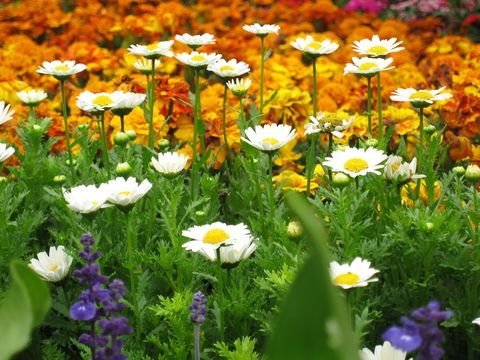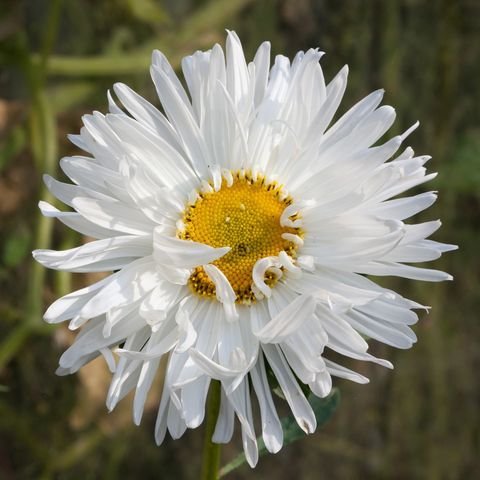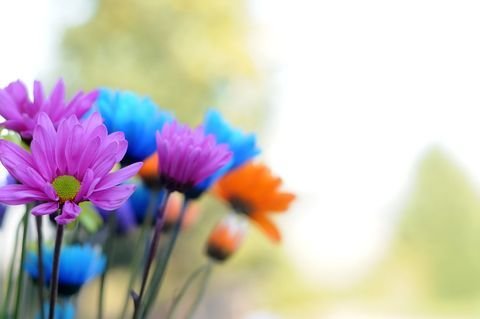Daisy Flower

| Photo: Tsz Yin Andrew Lee |
The daisy flower got it's name form 'daeges-eaye', an English term that translates to 'day's eye'. Daisies, with their yellow eyes, open with the sun then close when it goes down. These days-eye blooms are always a favorite with pollinators. They are distinguished by the ray of white petals that surrounds the yellow eye which can be composed of 15 to 30, or even more petals.
There are several flower species belonging to the Asteraceae family, which is also referred to as Compositae. Most of us are familiar with a few daisies.
- The Oxeye daisy
- The English daisy
- The Shasta daisy
So what is the difference?
|

|
|

|
|
It is a herbaceous wildflower and grows in florets and has short rhizomes. If there is a patch in your lawn it will keep popping up after cutting the grass. Digging up the root is the best way to remove plant.
|
-
Shasta Daisy - These are the cultivated garden favorites that we can pick up at our local nursery.
This species is named after Mount Shasta where Luther Burbank in 1890 crossed the Oxeye with a Japanese 'daisy'. The flower heads are larger and can grow up to 4 inches (10 cm) in diameter. These grow rapidly, and can adjust well to all types of soil.
The above mentioned are the most noted types of daisies. There is one wildflower that is known for survival in dry and rocky soil conditions called the Blackfoot Daisy (Melampodium porteri). Plant is heat and drought tolerant.
Commonly found in the southwest (planting zones 6-10) they are a mounding plant that grows in clumps averaging 6 inches high but can get as high as 1 foot. These grow on rocky surfaces. If placing these in a rock garden it is very important that there be good drainage.
Daisy flowers have different botanical names including Marguerite and Chrysanthemum. They can be a Echinacea, Guillardia, Leucanthemum, Helenium species and Dalea subspecies...
I couldn't resist ...

| Photo: Kaj Gardemeister |

| Photo: Vlue |
Back to Flowers to Attract Butterflies
Sitemap: Butterfly Websites
Back from Daisy Flowers to home page Easy Butterfly Garden
 Copyright © 2010-2022 Easy-Butterfly-Garden.com
Copyright © 2010-2022 Easy-Butterfly-Garden.com
Privacy Policy Disclaimer

Join Easy Butterfly Garden on Facebook
Recent Articles
-
Annual Bluegrass
Jan 14, 17 08:14 PM
Annual bluegrass (Poa annua) is considered a weed in the Poa family, which has a few popular turf grasses. If this gets into your butterfly garden listed are a few ways to eradicate it.
-
Candytuft Flowers
Sep 25, 16 10:54 PM
There are the annual, or Iberis, candytuft flowers and also perennials which are called Iberis sempervirens.
-
Keeping Deer Out
Sep 19, 16 01:10 PM
Reviewing the types of products available for keeping deer out of our gardens along with building fences. Many of these products help with other garden pests.
-
Butterfly Meadows
Sep 19, 16 12:52 PM
Compared to other wildlife gardening, butterfly meadows take time and are not for the faint of heart.
-
Natural Gardening
Sep 19, 16 12:32 PM
Natural gardening includes different types of gardens. These garden types create a casual, natural envirionment and help sustain native wildlife which includes butterflies.






New! Comments
Have your say about what you just read! Leave me a comment in the box below.